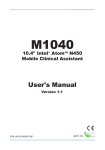Download Dell 1720 - Vostro - Core 2 Duo 2.2 GHz Specifications
Transcript
Dell™ Vostro™ 1720 Service Manual Working on Your Computer Adding and Replacing Parts Specifications Diagnostics System Setup Notes, Cautions, and Warnings NOTE: A NOTE indicates important information that helps you make better use of your computer. CAUTION: A CAUTION indicates potential damage to hardware or loss of data if instructions are not followed. WARNING: A WARNING indicates a potential for property damage, personal injury, or death. If you purchased a Dell™ n Series computer, any references in this document to Microsoft® Windows® operating systems are not applicable. Information in this document is subject to change without notice. © 2009 Dell Inc. All rights reserved. Reproduction of this material in any manner whatsoever without the written permission of Dell Inc. is strictly forbidden. Trademarks used in this text: Dell, the DELL logo, Vostro, TravelLite, Wi-Fi Catcher, and ExpressCharge, are trademarks of Dell Inc.; Intel, Pentium, Celeron a n d Core are registered trademarks of Intel Corporation; Bluetooth is a registered trademark owned by Bluetooth SIG, Inc. and is used by Dell under license; TouchStrip is a trademark of Zvetco Biometrics, LLC; Blu-ray Disc is a trademark of the Blu-ray Disc Association; Microsoft, Windows, Windows Vista, and the Windows Vista start button are either trademarks or registered trademarks of Microsoft Corporation in the United States and/or other countries. Other trademarks and trade names may be used in this document to refer to either the entities claiming the marks and names or their products. Dell Inc. disclaims any proprietary interest in trademarks and trade names other than its own. May 2009 Rev. A00 Back to Contents Page System Setup Dell™ Vostro™ 1720 Service Manual Entering System Setup <F12> Menu Entering System Setup Press <F2> to enter System Setup and make changes to the user-definable settings. If you are having trouble entering Setup using this key, reboot and press the <F2> key when the keyboard LEDs first flash. <F12> Menu Press <F12> when the Dell logo appears to initiate a one-time boot menu with a list of the valid boot devices for the computer. The devices listed on the boot menu depend on the bootable devices installed in the computer. l l l l l Internal HDD CD/DVD/CD-RW Drive Onboard NIC BIOS Setup Diagnostics (starts the Pre-boot System Assessment (PSA) diagnostics) This menu is useful when attempting to boot to a particular device or to bring up the diagnostics for the computer. Using the boot menu does not make any changes to the boot order stored in the BIOS. Back to Contents Page Diagnostics Dell™ Vostro™ 1720 Service Manual Device Status Lights LED Error Codes Power Button Light Codes Device Status Lights 1—Turns on when your computer reads or writes data to the hard drive. NOTE: To avoid loss of data, never turn off your computer while the Hard Drive light is flashing. 2—Turns on when wireless networking is enabled. 3—Turns on when a card with Bluetooth® wireless technology is enabled. NOTE: The card with Bluetooth wireless technology is an optional feature, so the light turns on only if you ordered the card with your computer. For more information, see the documentation that came with your card. To turn off only the Bluetooth wireless technology functionality, right-click the icon in the system tray and click Disable Bluetooth Radio. 4—Turns on when the numeric keypad is enabled. 5—Turns on when the uppercase letter function is enabled. 6—Turns on when the scroll lock function is enabled. Device status lights located in the center of the hinge cover. If your computer is connected to an electrical outlet, the l l If your computer is running on a battery, the l l l light operates as follows: Solid blue—The battery is charging. Flashing blue—The battery is almost fully charged. light operates as follows: Off—The battery is adequately charged, or the computer is turned off. Flashing orange—The battery charge is low. Solid orange—The battery charge is critically low. LED Error Codes If your computer does not perform a Power-On Self-Test upon boot up, there are various things to look for: 1. 2. 3. Check that the computer power light is on. If the power light is not on, ensure that your computer is plugged into AC power. Remove the battery. If your computer is powered on but is not performing a POST, check to see whether or not the keyboard status lights flash to indicate a successful POST but no video or if the keyboard status lights are lit in a sequence indicating a system problem. The following table shows the possible LED codes that may display in a no-POST situation. Appearance Description ON-FLASH-FLASH Next Step 1. 2. 4. Install supported memory modules. If memory is already present, reseat the module(s) one at time in each slot. Try known good memory from another computer or replace the memory. Replace the system board. System board error 1. 2. 3. Reseat the processor. Replace the system board. Replace the processor. LCD Panel Error 1. 2. 3. Reseat the LCD cable. Replace the LCD panel. Replace the video card / system board. 1. Install compatible memory modules. No SODIMMs are installed 3. FLASH-ON-ON FLASH-ON-FLASH OFF-FLASH-OFF 2. Memory compatability error 3. 4. ON-FLASH-ON 1. 2. Memory is detected but has errors If two modules are installed remove one and test. Try the other module in the same slot and test. Test the other slot with both modules. Replace the memory. Replace the system board. 3. 4. Reseat the memory. If two modules are installed remove one and test. Try the other module in the same slot and test. Test the other slot with both modules. Replace the memory Replace the system board. 1. 2. 3. Reseat the modem. Replace the modem. Replace the system board. 1. Replace the system board. 1. 2. 3. Reseat the device. Replace the device. Replace the system board. 1. 2. 3. 4. Reseat the hard drive and optical drive. Test the computer with just the hard drive and just the optical drive. Replace the device that is causing the failure. Replace the system board. 1. Replace the system board. OFF-FLASH-FLASH Modem Error FLASH-FLASH-FLASH System board error FLASH-FLASH-OFF Option ROM Error OFF-ON-OFF Storage device error FLASH-FLASH-ON Video card error Power Button Light Codes The power LED located in the power button on the front of the computer illuminates and blinks or remains solid to indicate five different states: l l l l l No light—System is in the off state (S5, or mechanical (AC power not applied) OFF). Solid Amber—System fault, but power supply is good—normal operating state (S0). Blinking Amber—System fault error condition including Power Supply (only +5VSB working), Vreg failure, missing or bad CPU. Blinking Green—System is in power saving states S1, S3 or S4. (Blink rate is 1Hz). No fault/error condition. Solid Green—System is fully functional and is in S0 (ON) state. Back to Contents Page Adding and Replacing Parts Dell™ Vostro™ 1720 Service Manual Battery Coin-Cell Battery Access Panel Optical Drive Hard Drive Wireless Local Area Network (WLAN) Card Memory Fan Heat Sink and Processor Internal Card With Bluetooth® Wireless Technology Hinge Cover Keyboard Palm Rest USB/IEEE 1394 Board System Board Display Assembly Display Bezel Display Inverter Camera LCD Display Panel Display Assembly Hinges Speaker Assembly Power Button and Multimedia Button Pads Back to Contents Page Specifications Dell™ Vostro™ 1720 Service Manual Processor Display System Information Keyboard ExpressCard™ Touch Pad 8-in-1-Memory Card Reader Fingerprint Reader Memory Camera Ports and Connectors Battery Communications AC Adapter Video Physical Audio Environmental NOTE: Offerings may vary by region. For more information regarding the configuration of your computer, click Start (or Start in Windows XP)® Help and Support, and then select the option to view information about your computer. Processor Processor type Intel® Core™2 Duo (2.0 - 2.66 GHz) Intel Celeron® (2.0 - 2.2 GHz) Intel Celeron Dual Core (1.66 - 1.86 GHz) processor L1 cache 32 KB per instruction, 32 KB data cache per core L2 cache Shared 3 MB or 6 MB External bus frequency 1067 MHz System Information System chipset Intel GM45 or Intel PM45 chipset Data bus width 64 bits DRAM bus width Dual-channel 64-bit bus Processor address bus width 36 bits Flash EPROM 1 MB PCI bus (discrete graphics only) x16 PCI Express ExpressCard™ NOTE: The ExpressCard slot is designed only for ExpressCards. It does NOT support PC cards. ExpressCard controller Integrated ExpressCard connector 54-mm ExpressCard slot (supports both USB- and PCIe-based interfaces) Cards supported 34-mm and 54-mm ExpressCards 8-in-1 Memory Card Reader Media card controller O2Micro OZ888 Media card connector 8-in-1 combo card connector Cards supported SecureDigital (SD), SDIO, MultiMediaCard (MMC), Memory Stick, Memory Stick Pro, xD-Picture Card, Hi Speed-SD, and Hi Density-SD Memory Memory module connector Two DIMM sockets Memory module capacities 1 GB (one DIMM) 2 GB (one DIMM or two DIMMs) 4 GB (2 DIMMs) 8 GB (two DIMMS, requires 64-bit Windows Vista operating system) Memory type DDR2 800 MHz (if supported by chipset and/or processor combinations); non-ECC memory only Minimum memory 1 GB Maximum memory 8 GB (requires 64-bit Windows Vista operating system) Ports and Connectors Audio Microphone connector and stereo headphone/speakers connector IEEE 1394 One 4-pin connector Dock Optional USB Port Replicator only One dedicated half Mini-Card slot for WLAN Mini-card support (internal expansion slots) One dedicated half Mini-Card slot for WLAN One USB-based daughter card with Bluetooth® wireless technology (Dell Wireless 355) Network adapter RJ-45 connector USB, USB PowerShare and eSATA Six USB 2.0-compliant connectors Video 15-pin VGA video connector Communications Modem Supports external USB modem (optional) only Network adapter 10/100/1000 Ethernet LAN on system board Wireless WLAN PCI-e Mini-Card, Bluetooth V2.0 card Mobile Broadband None GPS None Video Video type Integrated on system board (hardware accelerated) Discrete Video controller Integrated video: Intel Extreme Discrete video: NVIDIA GeForce 9400M GS (NB9MGS), 128 bit Data bus Integrated video or PCI-Express video x16 Video memory Integrated video: up to 256 MB shared memory Discrete video: 512 MB dedicated memory Video output Video connector and multimode DisplayPort LCD interface LVDS Audio Audio type High-definition audio (HDA) Audio controller IDT 92HD81 Stereo conversion 24-bit (analog-to-digital and digital-to-analog) Interfaces: Internal Internal High Definition Audio External Microphone-in connector, stereo headphones/speakers connector Speaker One 2-watt, 4-ohm speakers Internal speaker amplifier 2W, stereo Volume controls Program menus, media control buttons Display Type (active-matrix TFT) 17 inch WXGA+/WUXGA Dimensions: Height 245.00 mm (9.64 inches) Width 383.00 mm (15.00 inches) Diagonal 431.70 mm (17.00 inches) Maximum Resolutions: WXGA+ w/anti-glare 1440x900 with 18-bit color (262 K) WUXGA with TrueLife 1920X1200 with 18-bit color (262 K) Refresh rate 60 Hz Operating angle 0° (closed) to 160° Viewing angles: Horizontal WXGA+: 55/55° Vertical WXGA+: 45/45° Pixel pitch WXGA 0.258 mm (.010 inch) WUXGA with TrueLife 0.23 (.009 inch) Controls Brightness can be controlled through keyboard shortcuts Keyboard Number of keys 105 (U.S. and Canada); 106 (Europe); 109 (Japan) Layout QWERTY/AZERTY/Kanji Size: Standard Full size Maximum 359.40 mm x 118.90 mm x 5.20 mm (14.15 x 4.681 x 0.205 inches) Touch Pad X/Y position resolution (graphics table mode) 240 CPI Size: Width 73.70 mm (2.90 inches) Height 43.10 mm (1.69 inches) Fingerprint Reader (Optional) Type UPEK TCS3 TouchStrip™ strip sensor with CMOS active capacitive pixel-sensing technology Camera (Optional) Still Resolution 1.3 mega-pixel Battery Type: 6-cell lithium-ion battery 56 WHr 8-cell lithium-ion battery 74 WHr Dimensions: Depth 6-cell and 8-cell lithium-ion battery 49.97mm (1.97 inches) Height 6-cell and 8-cell lithium-ion battery 20.20 mm (0.79 inches) Width 6-cell and 8-cell lithium-ion battery 271.00 mm (10.67 inches) Weight 6-cell lithium-ion battery 338.70 g 8-cell lithium-ion battery 429.60 g Voltage: 6-cell lithium-ion battery 11.1 V 8-cell lithium-ion battery 14.8 V Operating Time (approximate) 4-5 hours (6-cell) 6 hours or more (8-cell) NOTE: Varies depending on operating conditions and can be significantly reduced under certain powerintensive conditions Life span (approximate) 1 year Temperature range: Operating 0° to 40°C (32° to 104°F) Storage -10° to 65°C (14° to 149°F) Coin-cell battery CR2032 AC Adapter Input voltage 100-240 VAC (90W) Input current (maximum) 1.5 A (90W) Input frequency 50-60 Hz (90W) Temperature range: Operating 0° to 35°C (32° to 95°F) Storage -40° to 65°C ( -40° to 149°F) Output voltage 19.5 VDC Output current 5.62 A (maximum at 4-second pulse), 4.62 A (continuous) Dimensions: Height 15.00 mm (0.60 inches) Width 66.00 mm (2.60 inches) Depth 127.00 mm (5.00 inches) Weight 0.29 kg (0.64 lb) PA-10 90 W D-Series AC adapter: Output voltage 19.5 VDC Output current 4.62 A Height 33.80 mm (1.34 inches) Width 60.90 mm (2.39 inches) Depth 153.40 mm (6.04 inches) Weight (with cables) 0.46 kg (1.01 lbs) PA-3E 90 E-Series AC adapter: Output voltage 19.5 VDC Output current 4.62 A Height 15.00 mm (0.60 inches) Width 70.00 mm (2.80 inches) Depth 147.00 mm (5.80 inches) Weight 0.34 kg (0.76 lb) Physical Height Front: 29.00 mm (1.14 inches) Back: 40.50 mm (1.59 inches) Width 393.00 mm (15.47 inches) Depth 286.00 mm (11.26 inches) Weight (with 6-cell battery) 3.09 kg (6.85 lbs) Weight (with 8-cell battery) 3.18 kg (7.05 lbs) Environmental Temperature range: Operating 0° to 35° C (32° to 95° F) Storage -40° to 65° C (-40° to 149° F) Relative humidity (maximum): Operating 10% to 90% (noncondensing) Storage 5% to 95% (noncondensing) Maximum vibration (using a random-vibration spectrum that simulates user environment): Operating Storage 0.66 GRMS 1.30 GRMS Maximum shock (measured with hard drive in head-parked position and a 2-ms half-sine pulse): Operating 143 G Storage 163 G Altitude (maximum): Operating -15.2 to 3048 m ( -50 to 10,000 ft) Storage -15.2 to 3048 m ( -50 to 10,000 ft) Airborne contaminant level G2 or lower as defined by ANSI/ISA-S71.04-1985 Back to Contents Page Access Panel Dell™ Vostro™ 1720 Service Manual WARNING: Before working inside your computer, read the safety information that shipped with your computer. For additional safety best practices information, see the Regulatory Compliance Homepage at www.dell.com/regulatory_compliance. Removing the Access Panel 1. 2. Follow the procedures in Before Working Inside Your Computer. Remove the battery from the computer. 3. Remove the eight screws from the access panel. 4. Lift the edge of the access panel that is closest to the center of the computer. 5. Remove the access panel. Back to Contents Page Battery Dell™ Vostro™ 1720 Service Manual WARNING: Before working inside your computer, read the safety information that shipped with your computer. For additional safety best practices information, see the Regulatory Compliance Homepage at www.dell.com/regulatory_compliance. Removing the Battery 1. Follow the procedures in Before Working Inside Your Computer. 2. Slide the battery lock latches into the unlocked position. 3. Slide the battery toward the back of the computer to remove. Back to Contents Page Power Button and Multimedia Button Pads Dell™ Vostro™ 1720 Service Manual WARNING: Before working inside your computer, read the safety information that shipped with your computer. For additional safety best practices information, see the Regulatory Compliance Homepage at www.dell.com/regulatory_compliance. Removing the Power Button and Multimedia Button Pads 1. 2. 3. Follow the procedures in Before Working Inside Your Computer. Remove the battery from the computer. Remove the hinge cover from the computer. 4. Remove the screw that secures the power button pad to the computer. 5. Slide the power button pad to the right. 6. Remove the screw that secures the multimedia button pad to the computer. 7. Slide the multimedia button pad to the left. 8. Turn the multimedia button pad onto the keyboard. 9. Disconnect the data cable from the multimedia button pad. 10. Remove the two button pads from the computer. Back to Contents Page Coin-Cell Battery Dell™ Vostro™ 1720 Service Manual WARNING: Before working inside your computer, read the safety information that shipped with your computer. For additional safety best practices information, see the Regulatory Compliance Homepage at www.dell.com/regulatory_compliance. Removing the Coin-Cell Battery 1. 2. 3. Follow the procedures in Before Working Inside Your Computer. Remove the battery from the computer. Remove the access panel from the computer. 4. Insert scribe into slot and gently pry up the coin-cell battery. 5. Remove the coin-cell battery. Back to Contents Page Display Bezel Dell™ Vostro™ 1720 Service Manual WARNING: Before working inside your computer, read the safety information that shipped with your computer. For additional safety best practices information, see the Regulatory Compliance Homepage at www.dell.com/regulatory_compliance. Removing the Display Bezel 1. 2. Follow the procedures in Before Working Inside Your Computer. Remove the display assembly from the computer. 3. Remove the eight rubber screw covers from the display bezel. 4. Remove the eight screws that secure the bezel to the display assembly. 5. Remove the bezel from the display assembly. Back to Contents Page Camera Dell™ Vostro™ 1720 Service Manual WARNING: Before working inside your computer, read the safety information that shipped with your computer. For additional safety best practices information, see the Regulatory Compliance Homepage at www.dell.com/regulatory_compliance. Removing the Camera 1. 2. 3. Follow the procedures in Before Working Inside Your Computer. Remove the display assembly from the computer. Remove the display bezel from the display assembly. 4. Remove the screw that secures the camera to the display assembly. 5. Lift the camera from the retention bracket. 6. Disconnect the camera data cable. 7. Remove the camera from the display assembly. Back to Contents Page Display Assembly Hinges Dell™ Vostro™ 1720 Service Manual WARNING: Before working inside your computer, read the safety information that shipped with your computer. For additional safety best practices information, see the Regulatory Compliance Homepage at www.dell.com/regulatory_compliance. Removing the Display Assembly Hinges 1. 2. 3. 4. Follow the procedures in Before Working Inside Your Computer. Remove the display assembly from the computer. Remove the display bezel from the display assembly Remove the LCD display panel from the display assembly. 5. Remove the eight screws securing the hinges to the display panel assembly. 6. Slide the hinges away from the display panel assembly. 7. Remove the display panel hinges from the display panel assembly. Back to Contents Page Display Inverter Dell™ Vostro™ 1720 Service Manual WARNING: Before working inside your computer, read the safety information that shipped with your computer. For additional safety best practices information, see the Regulatory Compliance Homepage at www.dell.com/regulatory_compliance. Removing the Display Inverter 1. 2. Follow the procedures in Before Working Inside Your Computer. Remove the display assembly from the computer. 3. Disconnect the data cable from the display inverter. 4. Disconnect the power cable from the display inverter. 5. Remove the inverter from the display assembly. Back to Contents Page LCD Display Panel Dell™ Vostro™ 1720 Service Manual WARNING: Before working inside your computer, read the safety information that shipped with your computer. For additional safety best practices information, see the Regulatory Compliance Homepage at www.dell.com/regulatory_compliance. Removing the LCD Display Panel 1. 2. 3. Follow the procedures in Before Working Inside Your Computer. Remove the display assembly from the computer. Remove the display bezel from the display assembly. 4. Remove the two screws that secure the LCD display panel to the display assembly. 5. Remove the LCD display panel from the display assembly. Back to Contents Page Display Assembly Dell™ Vostro™ 1720 Service Manual WARNING: Before working inside your computer, read the safety information that shipped with your computer. For additional safety best practices information, see the Regulatory Compliance Homepage at www.dell.com/regulatory_compliance. Removing the Display Assembly 1. 2. 3. 4. Follow the procedures in Before Working Inside Your Computer. Remove the battery from the computer. Remove the hinge cover from the computer. Remove the keyboard from the computer. 5. Disconnect the antenna cables from the WLAN card. 6. Remove the three screws that secure the display assembly to the computer chassis. 7. Disconnect the camera data cable from the system board. 8. Remove the data and antenna cables from the palm rest. 9. Disconnect the display data cable from the system board. 10. Remove the four remaining screws that secure the display assembly to the computer chassis. 11. Lift the display assembly straight up and remove the display assembly from the computer. Back to Contents Page Fan Dell™ Vostro™ 1720 Service Manual WARNING: Before working inside your computer, read the safety information that shipped with your computer. For additional safety best practices information, see the Regulatory Compliance Homepage at www.dell.com/regulatory_compliance. Removing the Fan 1. 2. 3. Follow the procedures in Before Working Inside Your Computer. Remove the battery from the computer. Remove the access panel from the computer. 4. Disconnect the fan cable from the system board. 5. Remove the three fan screws. 6. Lift up on the fan and remove it from the computer. Back to Contents Page Hinge Cover Dell™ Vostro™ 1720 Service Manual WARNING: Before working inside your computer, read the safety information that shipped with your computer. For additional safety best practices information, see the Regulatory Compliance Homepage at www.dell.com/regulatory_compliance. Removing the Hinge Cover 1. 2. Follow the procedures in Before Working Inside Your Computer. Remove the battery from the computer. 3. Use a plastic scribe gently to pry the back side of the hinge cover away from the base of the computer. 4. Starting on the right side, separate the hinge cover from the base of the computer. 5. Continue to separate the hinge cover from the system working from right to left, then remove the hinge cover. Back to Contents Page Hard Drive Dell™ Vostro™ 1720 Service Manual WARNING: Before working inside your computer, read the safety information that shipped with your computer. For additional safety best practices information, see the Regulatory Compliance Homepage at www.dell.com/regulatory_compliance. Removing the Hard Drive 1. 2. Follow the procedures in Before Working Inside Your Computer. Remove the battery from the computer. 3. Remove the screw that secures the hard drive access panel to the base of the computer. 4. Insert a plastic scribe into the slot and lift up the access panel, then remove the panel from the computer. 5. Remove the two screws that secure the hard drive in place. 6. Slide the hard drive toward the right side of the computer. 7. Lift the hard drive from the computer. Back to Contents Page Keyboard Dell™ Vostro™ 1720 Service Manual WARNING: Before working inside your computer, read the safety information that shipped with your computer. For additional safety best practices information, see the Regulatory Compliance Homepage at www.dell.com/regulatory_compliance. Removing the Keyboard 1. 2. 3. Follow the procedures in Before Working Inside Your Computer. Remove the battery from the computer. Remove the power button and multimedia button boards from the computer. 4. Remove the four keyboard screws that secure the keyboard to the computer 5. Turn over the keyboard and lay it upside down on the work surface. 6. Open the keyboard data cable clip. 7. Remove the keyboard data cable from the clip. 8. Remove the keyboard from the computer. Back to Contents Page Memory Dell™ Vostro™ 1720 Service Manual WARNING: Before working inside your computer, read the safety information that shipped with your computer. For additional safety best practices information, see the Regulatory Compliance Homepage at www.dell.com/regulatory_compliance. Removing Memory Modules 1. 2. 3. Follow the procedures in Before Working Inside Your Computer. Remove the battery from the computer. Remove the access panel from the computer. 4. If applicable, remove the top memory module by using your fingertips to carefully spread apart the securing clips on each end of the top memory module connector until the memory module pops up. 5. Slide the memory module out of the socket. 6. If applicable, remove the bottom memory module by using your fingertips to carefully spread apart the securing clips on each end of the memory module connector until the memory module pops up. 7. Slide the memory module out of the socket. Back to Contents Page Optical Drive Dell™ Vostro™ 1720 Service Manual WARNING: Before working inside your computer, read the safety information that shipped with your computer. For additional safety best practices information, see the Regulatory Compliance Homepage at www.dell.com/regulatory_compliance. Removing the Optical Drive 1. 2. Follow the procedures in Before Working Inside Your Computer. Remove the battery from the computer. 3. Remove the screw that secures the optical drive in the computer chassis. 4. Insert a plastic scribe into the notch and slide the optical drive slightly out of the computer. 5. Remove optical drive from the computer. Back to Contents Page Palm Rest Dell™ Vostro™ 1720 Service Manual WARNING: Before working inside your computer, read the safety information that shipped with your computer. For additional safety best practices information, see the Regulatory Compliance Homepage at www.dell.com/regulatory_compliance. Removing the Palm Rest 1. 2. 3. 4. 5. Follow the procedures in Before Working Inside Your Computer. Remove the battery from the computer. Remove the power button and multimedia button pads from the computer. Remove the keyboard from the computer. Remove the display assembly from the computer. 6. Remove the eleven palm rest screws that secure the palm rest to the bottom of the computer. 7. Open the touch pad data cable clip. 8. Remove the touch pad data cable from the clip. 9. Open the fingerprint reader data cable clip. 10. Remove the fingerprint reader data cable from the clip. 11. Remove the nine palm rest screws that secure the palm rest to the top of the computer. 12. Remove the palm rest from the computer. Back to Contents Page Heat Sink and Processor Dell™ Vostro™ 1720 Service Manual WARNING: Before working inside your computer, read the safety information that shipped with your computer. For additional safety best practices information, see the Regulatory Compliance Homepage at www.dell.com/regulatory_compliance. Removing the Heat Sink and Processor 1. 2. 3. 4. Follow the procedures in Before Working Inside Your Computer. Remove the battery from the computer. Remove the access panel from the computer. Remove the fan from the computer. 5. Loosen the four captive screws that secure the heat sink to the system board. 6. Lift the edge of the heat sink that is closest to the center of system board. 7. Slide the heat sink toward the center of the computer, then lift up the heat sink and remove it from the computer. 8. Rotate the processor cam counterclockwise. 9. Lift the processor straight up from its socket, taking care not to bend any of the processor pins. Back to Contents Page Speaker Assembly Dell™ Vostro™ 1720 Service Manual WARNING: Before working inside your computer, read the safety information that shipped with your computer. For additional safety best practices information, see the Regulatory Compliance Homepage at www.dell.com/regulatory_compliance. Removing the Speaker Assembly 1. 2. 3. 4. 5. 6. 7. 8. 9. 10. 11. Follow the procedures in Before Working Inside Your Computer. Remove the battery from the computer. Remove the access panel from the computer. Remove the fan from the computer. Remove the hard drive from the computer. Remove the optical drive from the computer. Remove the hinge cover from the computer. Remove the keyboard from the computer. Remove the display assembly from the computer. Remove the palm rest from the computer. Remove the system board from the computer. 12. Remove the four screws that secure the speaker assembly to the computer chassis. 13. Remove the speaker assembly from the computer. Back to Contents Page System Board Dell™ Vostro™ 1720 Service Manual WARNING: Before working inside your Tablet-PC, read the safety information that shipped with your Tablet-PC. For additional safety best practices information, see the Regulatory Compliance Homepage at www.dell.com/regulatory_compliance. Removing the System Board 1. 2. 3. 4. 5. 6. 7. 8. 9. 10. Follow the procedures in Before Working Inside Your Computer. Remove the battery from the computer. Remove the access panel from the computer. Remove the fan from the computer. Remove the hard drive from the computer. Remove the optical drive from the computer. Remove the hinge cover from the computer. Remove the keyboard from the computer. Remove the display assembly from the computer. Remove the palm rest from the computer. 11. Disconnect the speaker cable from the system board. 12. Disconnect the USB/IEEE 1394 data cable from the system board. 13. Disconnect the Bluetooth® module cable from the system board. 14. Disconnect the power cable from the system board. 15. Remove the three screws that secure the system board to the computer chassis. 16. Remove the system board from the computer chassis. Back to Contents Page USB/IEEE 1394 Board Dell™ Vostro™ 1720 Service Manual WARNING: Before working inside your computer, read the safety information that shipped with your computer. For additional safety best practices information, see the Regulatory Compliance Homepage at www.dell.com/regulatory_compliance. Removing the USB/IEEE 1394 Board 1. 2. 3. 4. 5. 6. 7. 8. 9. 10. Follow the procedures in Before Working Inside Your Computer. Remove the battery from the computer. Remove the access panel from the computer. Remove the fan from the computer. Remove the hard drive from the computer. Remove the optical drive from the computer. Remove the hinge cover from the computer. Remove the keyboard from the computer. Remove the display assembly from the computer. Remove the palm rest from the computer. 11. Disconnect the USB board data cable from the USB board. 12. Remove the two screws that secure the USB board to the computer chassis. 13. Lift the inside edge of the USB board and remove the board from the computer. Back to Contents Page Wireless Local Area Network (WLAN) Card Dell™ Vostro™ 1720 Service Manual WARNING: Before working inside your computer, read the safety information that shipped with your computer. For additional safety best practices information, see the Regulatory Compliance Homepage at www.dell.com/regulatory_compliance. Removing the WLAN Card 1. 2. 3. Follow the procedures in Before Working Inside Your Computer. Remove the battery from the computer. Remove the access panel from the computer. 4. Disconnect the antenna cables from the WLAN card. 5. Remove the screw that secures the WLAN card to the computer. 6. Remove the WLAN card from the computer. Back to Contents Page Internal Card With Bluetooth® Wireless Technology Dell™ Vostro™ 1720 Service Manual WARNING: Before working inside your computer, read the safety information that shipped with your computer. For additional safety best practices information, see the Regulatory Compliance Homepage at www.dell.com/regulatory_compliance. Removing the Internal Card With Bluetooth Wireless Technology 1. 2. 3. Follow the procedures in Before Working Inside Your Computer. Remove the battery from the computer. Remove the hard drive from the computer. 4. Remove the screw that secures the Bluetooth module in place. 5. Lift the edge of the Bluetooth module closest to the front of the computer. 6. Disconnect the Bluetooth module data cable. 7. Remove the Bluetooth module from the computer. Back to Contents Page Working on Your Computer Dell™ Vostro™ 1720 Service Manual Before Working Inside Your Computer Recommended Tools Turning Off Your Computer After Working Inside Your Computer Before Working Inside Your Computer Use the following safety guidelines to help protect your computer from potential damage and to help to ensure your personal safety. Unless otherwise noted, each procedure included in this document assumes that the following conditions exist: l l l You have performed the steps in Working on Your Computer. You have read the safety information that shipped with your computer. A component can be replaced or—if purchased separately—installed by performing the removal procedure in reverse order. WARNING: Before working inside your computer, read the safety information that shipped with your computer. For additional safety best practices information, see the Regulatory Compliance Homepage at www.dell.com/regulatory_compliance. CAUTION: Only a certified service technician should perform repairs on your computer. Damage due to servicing that is not authorized by Dell is not covered by your warranty. CAUTION: To avoid electrostatic discharge, ground yourself by using a wrist grounding strap or by periodically touching an unpainted metal surface, such as a connector on the back of the computer. CAUTION: Handle components and cards with care. Do not touch the components or contacts on a card. Hold a card by its edges or by its metal mounting bracket. Hold a component such as a processor by its edges, not by its pins. CAUTION: When you disconnect a cable, pull on its connector or on its pull-tab, not on the cable itself. Some cables have connectors with locking tabs; if you are disconnecting this type of cable, press in on the locking tabs before you disconnect the cable. As you pull connectors apart, keep them evenly aligned to avoid bending any connector pins. Also, before you connect a cable, ensure that both connectors are correctly oriented and aligned. NOTE: The color of your computer and certain components may appear differently than shown in this document. To avoid damaging your computer, perform the following steps before you begin working inside the computer. 1. 2. 3. Ensure that your work surface is flat and clean to prevent the computer cover from being scratched. Turn off your computer (see Turning Off Your Computer). If the computer is connected to a docking device (docked) such as the optional Media Base or Battery Slice, undock it. CAUTION: To disconnect a network cable, first unplug the cable from your computer and then unplug the cable from the network device. 4. 5. 6. Disconnect all network cables from the computer. Disconnect your computer and all attached devices from their electrical outlets. Close the display and turn the computer upside-down on a flat work surface. CAUTION: To avoid damaging the system board, you must remove the main battery before you service the computer. 7. 8. 9. 10. Remove the main battery (see Removing the Battery). Turn the computer top-side up. Open the display. Press the power button to ground the system board. CAUTION: To guard against electrical shock, always unplug your computer from the electrical outlet before opening the display. CAUTION: Before touching anything inside your computer, ground yourself by touching an unpainted metal surface, such as the metal at the back of the computer. While you work, periodically touch an unpainted metal surface to dissipate static electricity, which could harm internal components. 11. 12. Remove any installed ExpressCards or Smart Cards from the appropriate slots. Remove the hard drive (see Removing the Hard Drive). Recommended Tools The procedures in this document may require the following tools: l l l l l Small flat-blade screwdriver #0 Phillips screwdriver #1 Phillips screwdriver Small plastic scribe Flash BIOS update program CD Turning Off Your Computer CAUTION: To avoid losing data, save and close all open files and exit all open programs before you turn off your computer. 1. Shut down the operating system: l In Windows Vista: Click Start l , then click the arrow in the lower-right corner of the Start menu as shown below, and then click Shut Down. In Windows XP: Click Start® Turn Off Computer® Turn Off. The computer turns off after the operating system shutdown process is complete. 2. Ensure that the computer and all attached devices are turned off. If your computer and attached devices did not automatically turn off when you shut down your operating system, press and hold the power button for about 4 seconds to turn them off. After Working Inside Your Computer After you complete any replacement procedure, ensure you connect any external devices, cards, and cables before turning on your computer. CAUTION: To avoid damage to the computer, use only the battery designed for this particular Dell computer. Do not use batteries designed for other Dell computers. 1. 2. Connect any external devices, such as a port replicator, battery slice, or media base, and replace any cards, such as an ExpressCard. Connect any telephone or network cables to your computer. CAUTION: To connect a network cable, first plug the cable into the network device and then plug it into the computer. 3. 4. 5. Replace the battery. Connect your computer and all attached devices to their electrical outlets. Turn on your computer.












































































